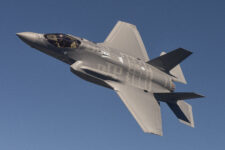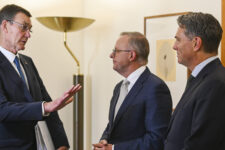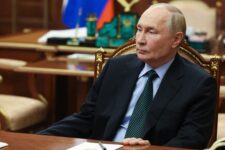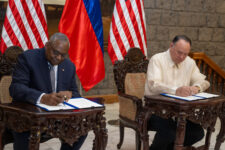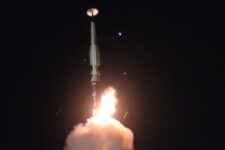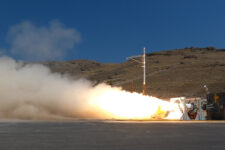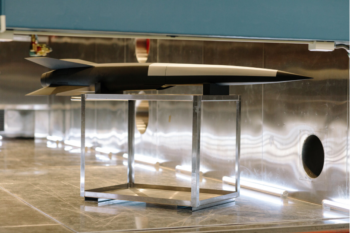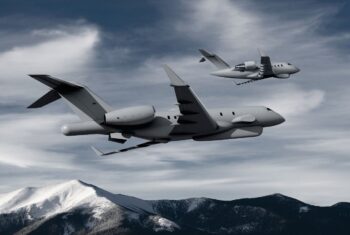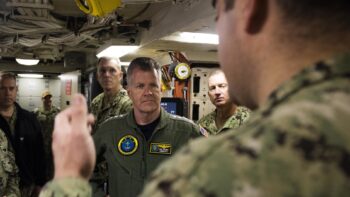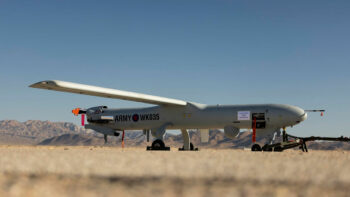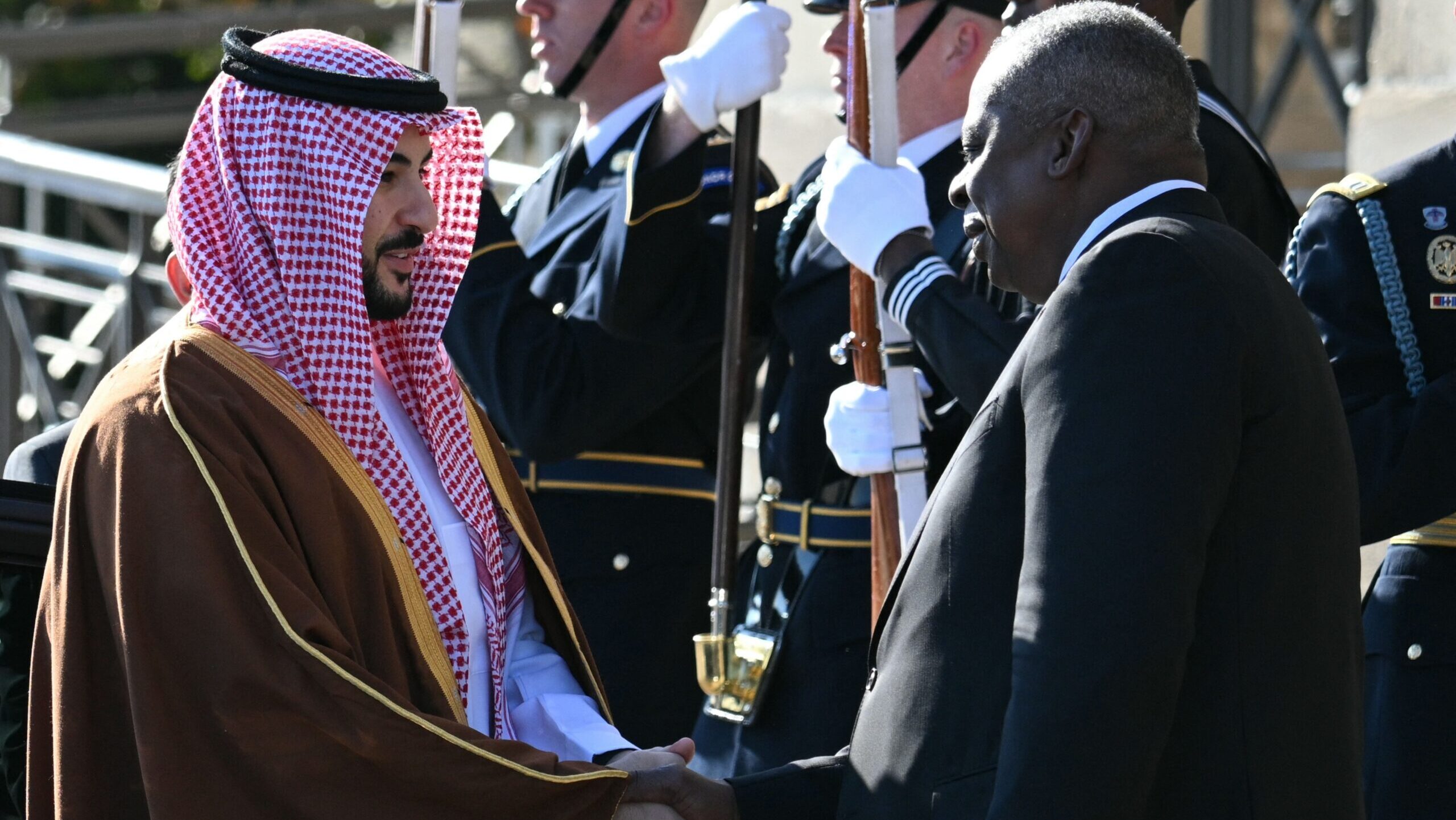
US Secretary of Defense Lloyd Austin welcomes Saudi Defense Minister Khalid bin Salman to the Pentagon in Washington, DC, on November 1, 2023. (Photo by Mandel NGAN / AFP) (Photo by MANDEL NGAN/AFP via Getty Images)
If Israel continues to oppose the creation of an independent Palestinian state, Saudi Arabia will not agree to normalize its relations with the Jewish state. In return, the United States will not extend official security guarantees to Riyadh. In this three-way, mega deal, which the Biden administration has promoted in recent years, if one leg fails, the whole thing falls apart.
But let’s assume for a moment that a US-Saudi defense pact comes to pass, be it through Saudi-Israeli normalization or a separate, bilateral agreement between the United States and Saudi Arabia. In that scenario, what would it take to make such a historic and unique defense arrangement in the region successful? This is an issue that, despite its critical importance, has received hardly any attention or scrutiny in Washington or Riyadh.
As consequential as a US-Saudi agreement on a mutual defense pact is, equally consequential is the content of the agreement, as well as its implementation. For it to be politically credible and militarily effective, a defense pact between nations must have three layers: military, strategic and institutional. All three must complement each other, and in the case of Saudi Arabia and the United States, none of these layers will be straightforward, as both countries have neglected or under-emphasized serious defense cooperation for decades.
RELATED: In dreams of a formal Gulf-US defense pact, what would Washington get?
Through Operation Desert Shield in 1990, the United States defended Saudi Arabia from Saddam Hussein and soon after liberated Kuwait from Iraqi occupation. Saudi Arabia provided the United States with access to its territory and it paid for the bulk of US military operations. It did some fighting in the air against Iraqi forces, but it barely fought with the Americans on the ground. Not much has changed since. To truly have an alliance where Saudi forces are expected to come to America’s defense, the two sides will need to build up connective tissue that, despite the closeness of the two governments, has never really been there. Joint contingency planning should be at the very top of the priority lists of the US and Saudi militaries.
Any deal will require language in the pact identifying Saudi Arabia as a treaty ally of the United States — a status enjoyed by no other US partner in the Middle East (minus Turkey, a NATO member) — and codifying US, and Saudi, military intervention in the event of an attack against either side.
Crafting that language will not be easy. On the one hand, too much detail on the circumstances that might compel either government to come to the defense of the other might corner both parties. Too much ambiguity, on the other, might allow adversaries — primarily Iran — to exploit loopholes and test the resolve of the alliance. Is an Iranian drone strike just into Saudi territory enough to trigger America’s aid? What happens if an Iranian proxy — the Houthis or Iraqi militias — but not Tehran itself, attacks Saudi Arabia? A balance must be struck to ensure deterrence.
Once both sides are clear about their mutual security commitments, they would have to create or upgrade joint institutional/bureaucratic mechanisms to enable the implementation efforts of their civilian officials and military personnel.
The US-Saudi strategic dialogue, which already exists and is held annually, is a good forum for both sides to consult on major issues of the pact. A higher-level version of the dialogue should be co-chaired by the US Secretary of Defense (or the Under Secretary of Defense for Policy) and the Saudi Minister of Defense. Its main task would be to offer strategic guidance to all entities involved in implementation.
The strategic dialogue would have to be supported by a lower-level but no less important structure to deal with longer-term posture, military, and technical matters — call it a joint military commission (which the United States has with several Arab partners who receive US military funding annually).
The commission’s chief goal would be to assess, monitor, and evaluate the workings of the defense pact. It would clarify how the United States could best posture itself militarily in the kingdom; how it could help Saudi Arabia develop stronger military capability; and how it could support existing Saudi defense reform to improve the capacities of the Saudi defense establishment. The commission would be led by the Saudi Chief of Defense and the US Assistant Secretary of Defense for Strategy, Plans, and Capabilities (with the support of the US Deputy Assistant Secretary of Defense for Middle East Policy).
This construct will pose a twin challenge for the Saudis, though not insurmountable. The first is Saudi human capacity. Riyadh, like all other Arab capitals, does not have a deep bench of skilled, working-level defense officials, to put it mildly. The onus will be on the Saudi leadership to identify and train a cadre of officials to make this relationship work.
The second challenge, perhaps greater than the first, is empowering those Saudi officials and allowing them to shape Saudi policy in ways like they have never done before. This is hugely important because if US officials see that their Saudi counterparts have few or no authorities, the cooperation will lose much of its credibility and significance.
If progress can be made on the strategic and institutional levels, the US and Saudi armed forces will benefit tremendously. With sufficient strategic clarity and effective civilian guidance, the militaries of both sides will have a better chance of implementing and sustaining the mutual defense pact.
Switching to a more collective security approach will require a significant cultural shift, both in Riyadh and in Washington. It’s not impossible, but it will take many years before a US-Saudi defense pact becomes worthy of its name.
Bilal Y. Saab is the Head of the US-Middle East Practice and an Advisor in the Scientific and Academic Council of TRENDS Research and Advisory
Romania signs LOA to secure entry to F-35 club
“This decision marks a significant milestone in Romania’s defense strategy and its commitment to maintaining a robust and advanced military force,” Lockheed Martin said in a statement.
